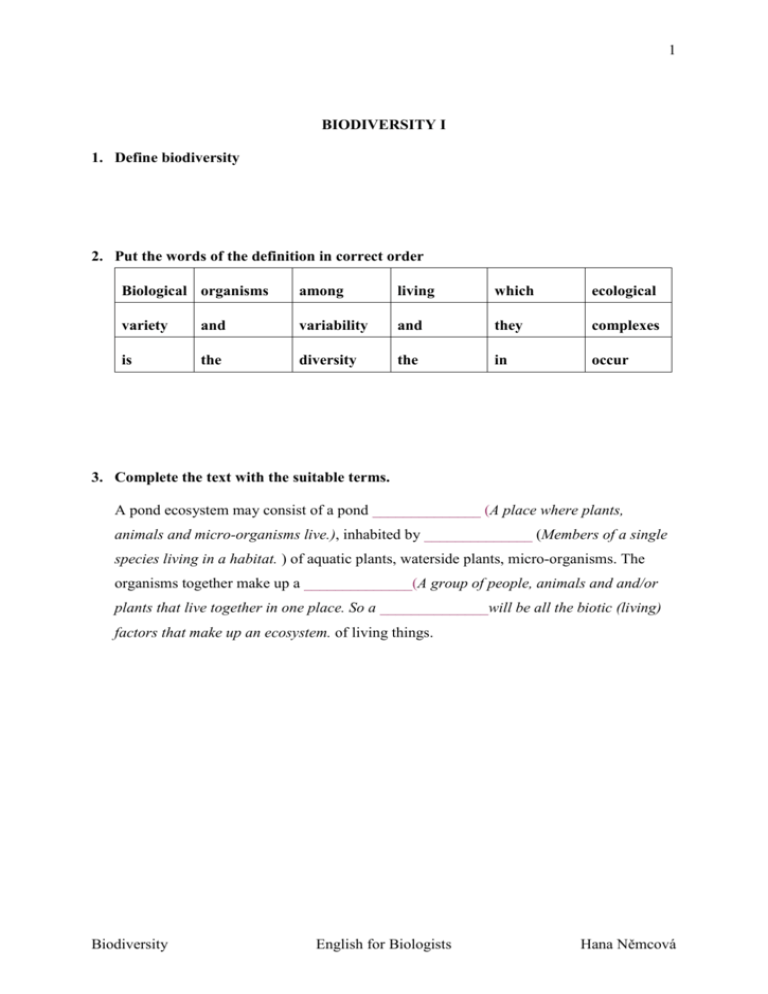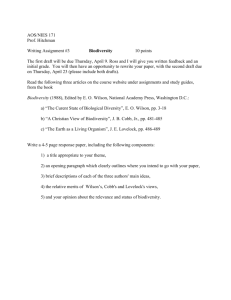biodiversity iv
advertisement

1 BIODIVERSITY I 1. Define biodiversity 2. Put the words of the definition in correct order Biological organisms among living which ecological variety and variability and they complexes is the diversity the in occur 3. Complete the text with the suitable terms. A pond ecosystem may consist of a pond ______________ (A place where plants, animals and micro-organisms live.), inhabited by ______________ (Members of a single species living in a habitat. ) of aquatic plants, waterside plants, micro-organisms. The organisms together make up a ______________(A group of people, animals and and/or plants that live together in one place. So a ______________will be all the biotic (living) factors that make up an ecosystem. of living things. Biodiversity English for Biologists Hana Němcová 2 4. Biodiversity can be divided into three hierarchical categories. What are they? Label the descriptions. _________________ diversity refers to the variation of genes within species. This covers distinct populations of the same species (such as the thousands of traditional rice varieties in India) or genetic variation within a populations (high among Indian rhinos, and very low among cheetahs)... _________________ diversity refers to the variety of species within a region. Such diversity can be measured in many ways, and scientists have not settled on a single best method. The number of species in a region -- its species "richness" -- is one often- used measure, but a more precise measurement, "taxonomic diversity", also considers the relationship of species to each other. For example, an island with two species of birds and one species of lizard has a greater taxonomic diversity than an island with three species of birds but no lizards... _________________ diversity is harder to measure than species or genetic diversity because the "boundaries" of communities -- associations of species -- and ecosystems are elusive. Nevertheless, as long as a consistent set of criteria is used to define communities and ecosystems, their numbers and distribution can be measured..." Adapted from: World Resources Institute, World Conservation Union, and United Nations Environment Programme, "Global Biodiversity Strategy," 1992: 3 BIODIVERSITY III Listening Comprehension: Diversity of Species http://www.bbc.co.uk/radio4/science/homeplanet_20030715.shtml (timing 11:16 -15:35) 1. Complete the information on the Amazon Basin project: object of area observation time costs 2. A lot of species become extinct. Anna believes that essential is whether a. we lose one species here and there b. the ecosystems continue functioning c. hundreds of new species appear 3. Choose the correct answer concerning the Biowatch Project The project takes place in: a. UK b. USA c. rainforest People taking part in the observation are: a. scientists b. volunteers c. students The most important contribution of the project is: a. it will help us to solve the problem with the huge extinction b. it provides detailed observations of how species are distributed c. the public is involved in the biodiversity management Post-listening: 1. Have you heard of similar projects focusing on biodiversity in the Czech Republic? Would you like to take part in a project like this? Biodiversity English for Biologists Hana Němcová 4 BIODIVERSITY IV 1. The title of the article is “Biological Diversity under Attack”. Brainstorm a list of key words that may appear in the text. 2. Underline the key words in the main ideas of the passage in question. Then list as many synonyms as possible. (see Main Idea Check) 3. Identify the paragraphs by scanning the text. Write the correct paragraph number beside its main idea. Scanning technique: 1. decide what information is needed 2. draw up a list of possible key words (including synonyms) which may occur in the text referring to question topic 3. scan for instances of key words 4. read carefully those sentences and/or paragraphs where the keywords occur and decide if the information is relevant 5. repeat steps 3) and 4) until all relevant information is available 5. Answer the questions on the article (see A Closer Look) This section is based on Pakenham, J. Making Connections, CUP, 1998 Sources: http://www.bbc.co.uk/schools/gcsebitesize/science/ocr_gateway/environment/0_ecology_orga nisms1.shtml http://en.wikipedia.org http://biodiversity.ca.gov/Biodiversity/biodiv_def2.html Pakenham, J. Making Connections, CUP, 1998






